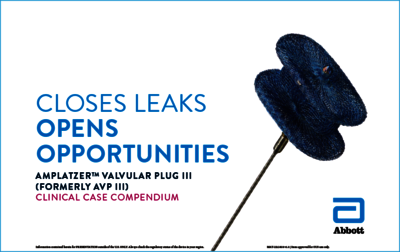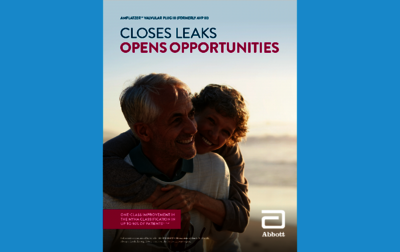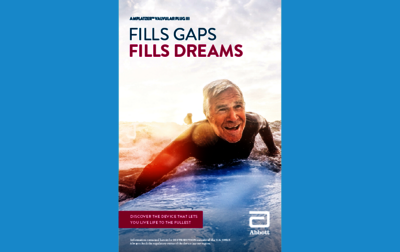VALVULAR PLUG III
STRUCTURAL INTERVENTIONS
Paravalvular leaks (PVLs) are a common and challenging problem around the world.1 The Amplatzer™ Valvular Plug III is specially designed to provide an effective solution to this key issue, improving quality of life and longevity for an increasing number of patients.2–5
CLINICALLY PROVEN OUTCOMES
Clinical studies continue to show that the Amplatzer™ Valvular Plug III, formerly known as AVP III, is a highly effective solution in closing PVLs near mechanical surgical valves.3,4,6

UP TO 93% of PVLs reduced to moderate or less.6,7

UP TO 90% of patients report one-class NYHA classification improvement.3,6,8,9
LEARN MORE:
A SOLUTION THAT HAS RECEIVED CLOSE ATTENTION5–7, 10,11 — AND STRONGLY POSITIVE REVIEWS.12
| OVERALL - MITRAL AND AORTIC | CRUZ-GONZALES 2014 | SMOLKA 2016 | DAVIDAVICIUS 2014 | SWAANS 2021 | WERNER 2018 | |
|---|---|---|---|---|---|---|
| Number of patients (number of PVLs) | 33 (34) | 49 (49) | 7 (9) | 7 (7) | 10 (17) | |
| Mitral/ Aortic PVL | 27 / 7 | 29 / 20 | 9 / 0 | 6 / 1 | 12 / 5 | |
| Mechanical/ Tissue | 32 / 1 | 30 / 19 | 4 / 3 | 4 / 3 | 4 / 6 | |
| Indication for PVLs (% patients (N)) | Heart failure | 21.2% (7) | 89.8% (44) | 57.1%(4) | 14.2%(1) | 50% (5) |
| Hemolytic anemia | 3% (1) | 0%* | 0% | 42.9% (3) | 0% | |
| Both | 75.7% (25) | 10.2% | 42.9% (3) | 42.9% (3) | 50% (5) | |
| Access (TA: transapical, TS: transseptal, TF: transfemoral) | Mitral: TF, TS Aortic: TF | Mitral: TS,TA Aortic: TF | Mitral: TA Aortic: n/a | Mitral: TA Aortic: TA | Mitral: TS,TA Aortic: TF | |
| Follow-up | 90 days | 6 months, 1 year | 40–364 days | 3 months | 1 year | |
| COMPOSITE ENDPOINT | ||||||
| Technical success (overall) | 90.9% | 93.9% | 100% | 100% | 86% | |
| Mitral | 92.3% | 89.7% | 100% | 100% | NR | |
| Aortic | 100% | 100% | n/a | 100% | NR | |
| SAFETY ENDPOINTS | ||||||
| Survival | Intraprocedural | 100% | 100% | 100% | 100% | 100% |
| 30 days | 100% | 98% | 100% | 100% | 80% | |
| Follow-up | 100% | 95.9% | 85.7% | 85.7% | 70% | |
| Stroke (30 days) | 0 | 2% | NR | 0 | 0 | |
| Conversion to surgery | 6% | NR | 0 | 14.2% | 0 | |
| Bleeding/ vascular complications | 12% | 2% | 28.6% | 14.2% | 20% | |
| EFFECTIVENESS ENDPOINTS | ||||||
| % patients with absent to moderate PVL regurgitation | 100% | 93.8% | 100% | 100% | NR | |
| % patients with reduction in NYHA class | 90.3% | 90.5% | 85.7% | 71.4% | NR | |
| Hemolysis | Improved | Improved | Improved | NS | NR | |
Clinical Case clubs | Educational tools | Hot topics
Expert opinions | Live & online discussions
HUB
- Rama-Merchan J, Arribas-Jimenez A, et al. Prevalence and severity of paravalvular regurgitation in the Artificial Valve Endocarditis Reduction Trial (AVERT) echocardiography study. Rev Esp Cardiol. 2014;67:593–596.
- Ruiz CE, Hahn RT, Berrebi A, et al. Clinical trial principles and endpoint definitions for paravalvular leaks in surgical prosthesis: an expert statement. J Am Coll Cardiol. 2017;69(16):2067–2087. doi.org/10.1016/j.jacc.2017.02.038.
- Calvert PA, Northridge DB, Malik IS, et al. Percutaneous device closure of paravalvular leak: combined experience from the United Kingdom and Ireland. Circulation. 2016;134(13):934–944. doi.org/10.1161/CIRCULATIONAHA.116.022684.
- García E, Arzamendi D, Jimenez-Quevedo P, et al. Outcomes and predictors of success and complications for paravalvular leak closure: an analysis of the SpanisH real-wOrld paravalvular LEaks closure (HOLE) registry. EuroIntervention. 2017;12(16):1962–1968. doi.org/10.4244/EIJ-D-16-00581.
- Davidavicius G, Rucinskas K, Drasutiene A, et al. Hybrid approach for transcatheter paravalvular leak closure of mitral prosthesis in high-risk patients through transapical access. J Thorac Cardiovasc Surg. 2014;148(5):1965–1969. doi.org/10.1016/j.jtcvs.2014.05.001.
- Smolka G, Pysz P, Jasinski M, et al. Multiplug paravalvular leak closure using Amplatzer Vascular Plugs III: a prospective registry. Catheter Cardiovasc Interv.
- Cruz-Gonzalez I, Rama-Merchan J, Arribas-Jimenez A, et al. Prevalence and severity of paravalvular regurgitation in the Artificial Valve Endocarditis Reduction Trial (AVERT) echocardiography study. Rev Esp Cardiol. 2014;67:593–596.
- Yildirim A, Goktekin O, Gorgulu S, et al. A new specific device in transcatheter prosthetic paravalvular leak closure: a prospective two-center trial. Catheter Cardiovasc Interv. 2016;88(4):618–624. doi.org/10.1002/ccd.26439.
- Angulo-Llanos R, Sarnago-Cebada F, Rivera AR, et al. Two-year follow up after surgical versus percutaneous paravalvular leak closure: a non-randomized analysis.
- Swaans MJ, Post MC, van der Ven HA, et al. Transapical treatment of paravalvular leaks in patients with a logistic EuroSCORE of more than 15%: acute and 3-month outcomes of a “proof of concept” study. Catheter Cardiovasc Interv. 2012;79(5):741–747. doi.org/10.1002/ccd.23264.
- Werner N, Zeymer U, Fraiture B, et al. Interventional treatment of paravalvular regurgitation by plug implantation following prosthetic valve replacement: a single-center experience. Clin Res Cardiol. 2018;107(12):1160–1169. doi.org/10.1007/s00392-018-1290-7.
- Data on File at Abbott.


